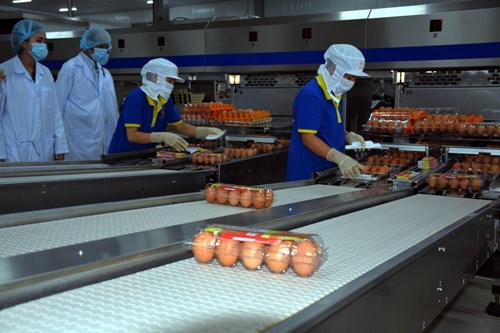1. Accomplishing 13 socio-economic targets with the highest GDP growth rate since 2011
    |
 |
| Vietnam completed and surpassed all 13 socio-economic set targets for the first time in years. Photo for illustration |
Vietnam completed and surpassed all 13 socio-economic set targets for the first time in years. Accordingly, gross domestic product (GDP) had an increase of 6.81 percent against 2016, especially in the third quarter (7.46 percent) and the fourth quarter (7.65 percent). In addition, the Vietnamese stock market had a record increase. Along with high GDP growth rate, the macro economy was stable; inflation was under control, while the State budget collection and major economic indicators met requirements. The average CPI (Consumer Price Index) in 2017 had an increase of only 3.53 percent in comparison with 2016. Such outcomes created favorable momentum for the country to push ahead with development and implement the Resolution adopted at the 12th Congress of the Communist Party of Vietnam.
2. Handling complicated corruption cases, contributing to trust building in the nation:
Over the last year, a number of serious and complicated economic and corruption cases were handled in the light of the Resolution on Party building and revamping adopted by the fourth Party Central Committee (12th tenure). Handling high-ranking officials, incumbent or retired, has demonstrated that there is no “prohibited zone” in the fight against corruption and affirmed the determination of the whole political system and society to combat corruption and other negative phenomena, contributing to building trust among the people.
    |
 |
| There is no “prohibited zone” in the fight against corruption. Photo for illustration |
3. Total trade turnover exceeded USD 400 billion
Vietnam's total export-import turnover since the beginning of the year reached USD 425 billion, recording the highest trade surplus ever, at USD 3.17 billion.
4. Efforts to simplify administrative procedures, reduce business conditions
In 2017, ministries, sectors and localities in the country gained achievements in the reform of administrative procedures, reducing business conditions, creating favorable conditions for enterprises and people. In particular, the Ministry of Industry and Trade is pioneering the reform of business conditions. With the highest determination, in September 2017, the Ministry of Industry and Trade reduced hundreds of business conditions. Other ministries, such as the Ministry of Agriculture and Rural Development, the Ministry of Finance, the Ministry of Health, also actively reduced business conditions, streamlining many administrative procedures to facilitate companies' customs clearance and business activities.
5. Progress in equitization of State-owned enterprises
The Ministry of Industry and Trade on December 18 sold all of its 343.6 million shares (or a 53.6 percent stake) in the Saigon Beer, Alcohol and Beverage Corporation (Sabeco), receiving an estimated VND 110 trillion (USD 4.89 billion). This was an important event to show the commitment of the government to address difficulties facing State-owned enterprises privatization and speed up the progress.
6. Natural disasters causing heavy losses of both human lives and property
A large-scale cold spell in Northern mountainous provinces, continuous floods in the Central region, drought in the Central Highlands and saline intrusion in the Mekong Delta caused severe impacts on production and daily life of local people in 2016. In which, Storm Damrey, the strongest storm to hit Vietnam in years, suddenly landed on the South Central coast of Vietnam, leaving 123 people dead and missing, and damaging many houses, causing heavy losses of human lives and property. Administrations at all levels, sectors and the entire community actively helped support affected people to stabilize their production and life, shift production models and respond to climate change.
7. Special policies for development of regions throughout the country adopted
Vietnam’s National Assembly adopted a resolution to pilot special mechanisms and policies for the development of Ho Chi Minh City. The resolution also covers the mechanism on creating favorable conditions for the city to further develop.
Also at the fourth session, the National Assembly also approved a draft Law on special administrative-economic units located in Van Don (Quang Ninh province), North Van Phong (Khanh Hoa province) and Phu Quoc Island (Kien Giang province). The draft law enables these units to attract investors, build infrastructure for regional socio-economic development.
8. Vietnam welcomes nearly 13 million foreign tourists
Vietnam received around 13 million foreign visitors this year, a year-on-year increase of 28%. The growth brings the turnover of the tourism sector to over VND 510 trillion (USD 23 billion) this year, which is up 25.2 percent against last year and contributes seven percent to the country’s GDP.
9. Two more heritage elements honored by UNESCO
On December 7 and 8, 2017, at the 12th session of the UNESCO Inter-governmental Committee for the Safeguarding of the Intangible Cultural Heritage in Jeju, the Republic of Korea, UNESCO listed Vietnam’s “Xoan” singing in Northern Phu Tho province and “bai choi” singing in the Central region in the Representative List of the Intangible Cultural Heritage of Humanity. Up to now, Vietnam had 10 intangible heritage elements listed in the UNESCO’s List of Intangible Cultural Heritage in Need of Urgent Safeguarding.
10. Health sector faces dengue fever epidemic, serious medical incidents nationwide
In 2017, dengue fever broke out and spread across 63 cities and provinces with 163,600 cases, including 138,327 patients hospitalized and 30 fatalities. Those incidents required the health sector to look for effective measures to prevent further outbreaks of the disease and improve management.
Translated by Minh Anh